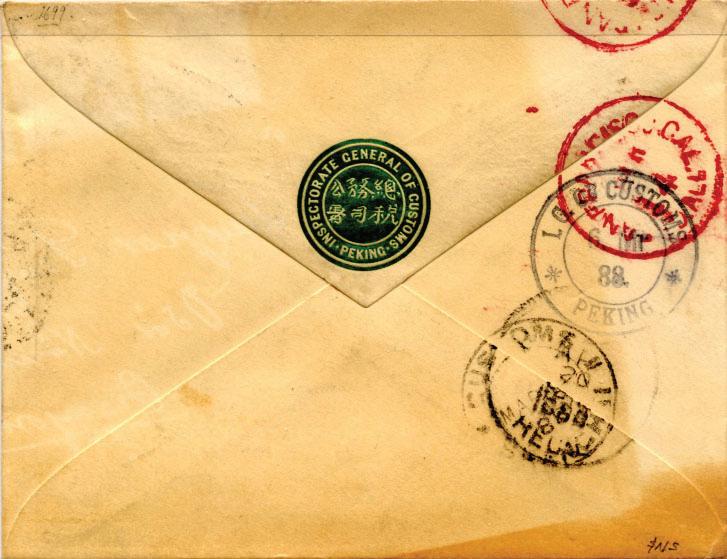
5 minute read
Raman Spectrum Analysis of 1888 San Francisco Red Cancel by Mel Kravitz RPSL
Raman Spectrum Analysis of 1888 San Francisco Red Cancel
Mel Kravitz RPSL
Advertisement
Figure 1a.
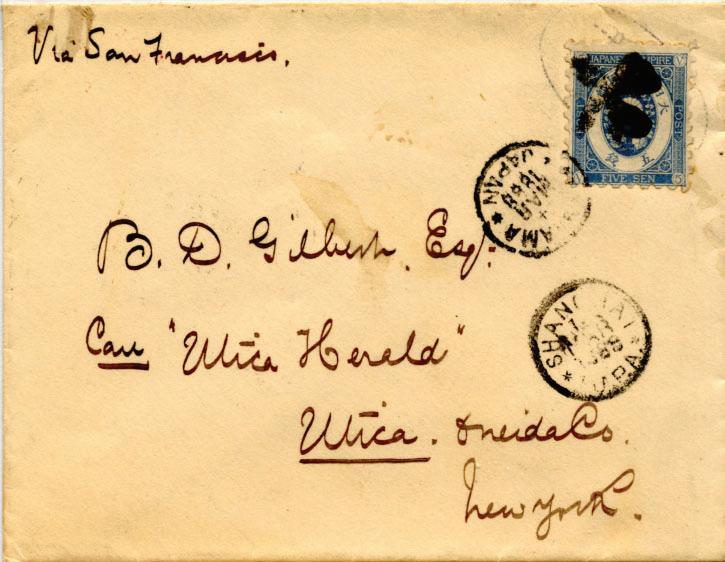
Figure 1b.
282 September-October 2022 www.collectorsclub.org
This short piece involves the determination of the San Francisco incoming red transit ink, used on mail from China, passing through the U.S. Post Offi ce Department at San Francisco in 1888 receiving a transit CDS in red ink. This evaluation will be made using Micro Raman spectrometry, on a lett er sent from Peking China in 1888 to Utica, N.Y., shown to the left in Figures1a and 1b.
Figure 1a, and 1b (top left and bott om left). Customs Post offi ce Peking ‘Mail Matt er’ lett er sent to Utica, N.Y., March 6, 1888. The “San Francisco Cal PAID ALL” transit CDS lett ers in red ink are relatively clear and represent good test points. The “L” of ”CAL” will be used as test point No.1. Initially the 785nm laser will be used, backed up, if necessary, by the 532nm laser, since this may be Cinnabar ink, which is bett er detected using the 785nm laser.
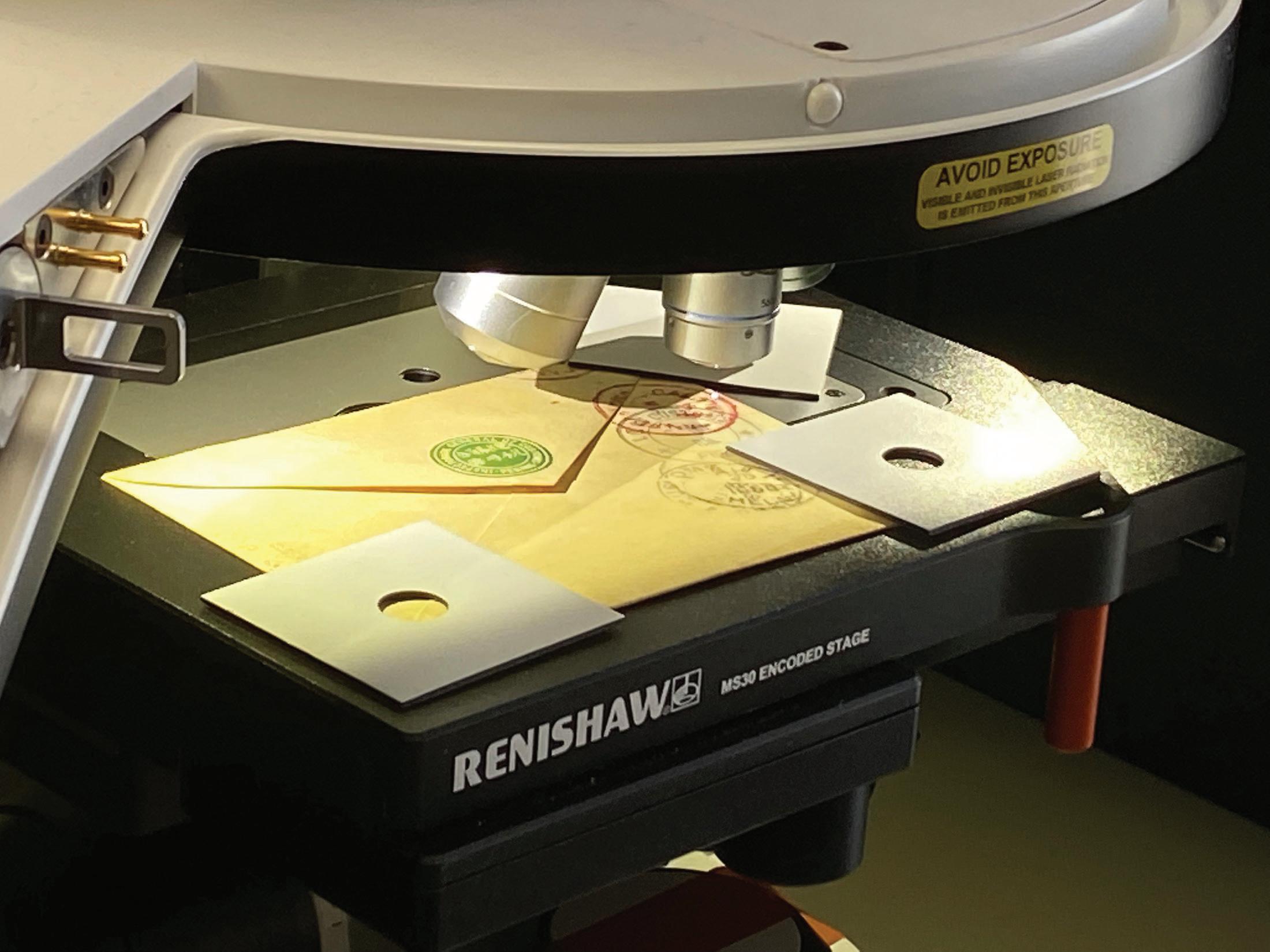
Figure 2. Test setup, using the x50WLD microscope in the Class I enclosure of the Renishaw Invia Raman instrument.
Don’t forget!
Our library is a great member resource! Online CCNY Library information is available
www.collectorsclub.org/the-collectors-club-library/
Collectors Club Philatelist Volume 101, Number 5 283
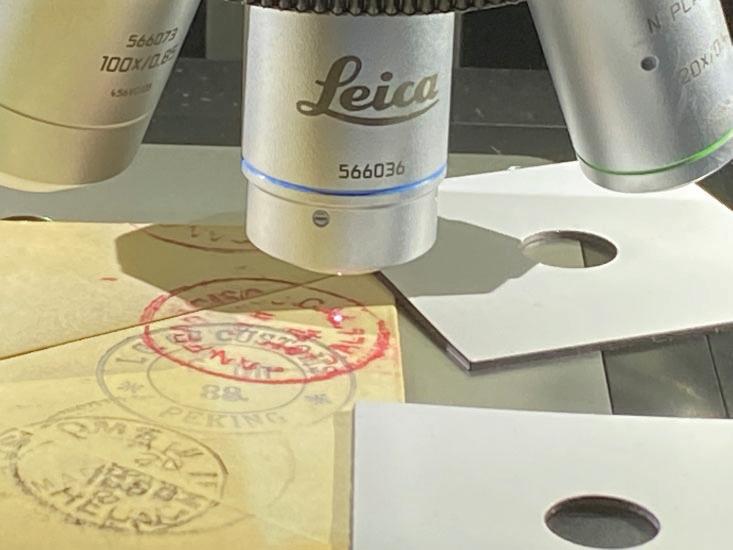
Figure 3. San Francisco transit CDS ink at test point No. 1, the “L” of CAL, as shown above illuminated using the x50WLD microscope.
Figure 4. San Francisco transit CDS August 1888 ink at test point No. 1 magnifi ed x50 and the corresponding raw Raman spectrum. The 785nm laser used at 0.1% power or 1.13 milliwatt s, 15 sec. scan time, repeating two times. The ink is not Cinnabar ( HgS).
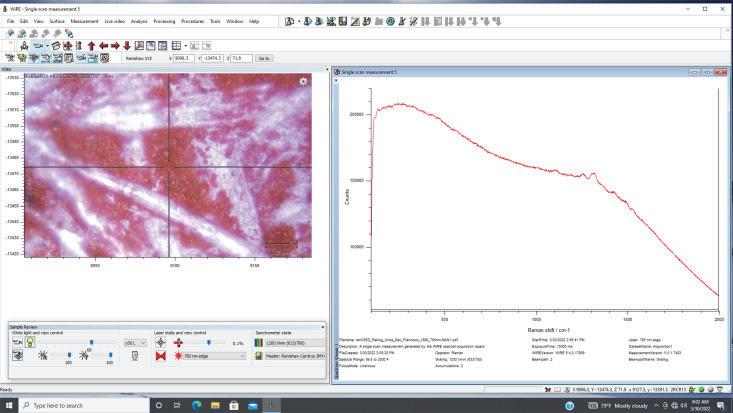
284 September-October 2022 www.collectorsclub.org
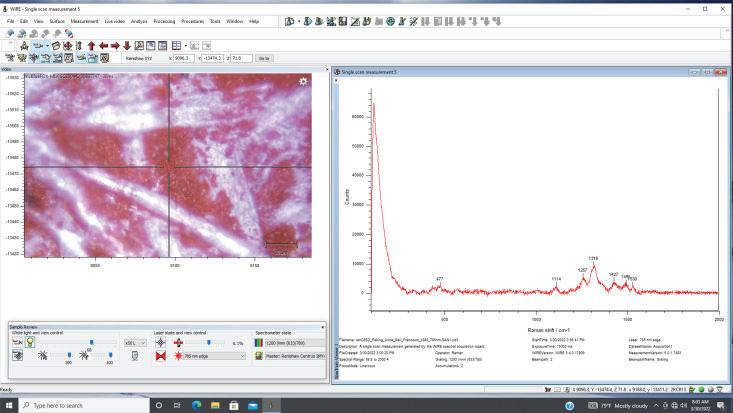
Figure 5. San Francisco transit CDS August 1888 ink at test point No. 1, with base line corrected, Raman spectrum. With peaks at 477, 1114, 1257, 1316, 1427, 1495 and 1530 Raman shift / cm -1. This ink does not appear in a saved library; research of the existing literature will be required for matching and compound identifi cation.
Figure 6. Expanded Raman spectrum of San Francisco transit CDS August 1888 ink at test point No. 1. The literature resulted in a match to research on Cochineal lake dye. The published Raman spectrum is shown in Figure 7.
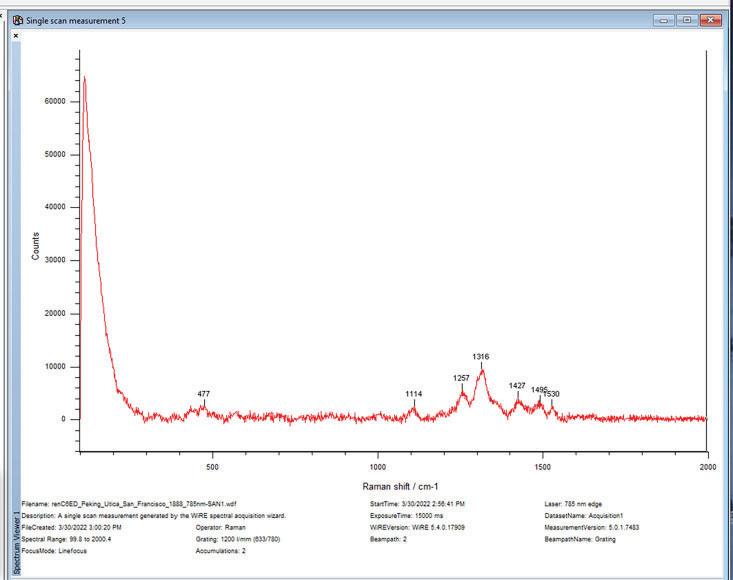
Collectors Club Philatelist Volume 101, Number 5 285
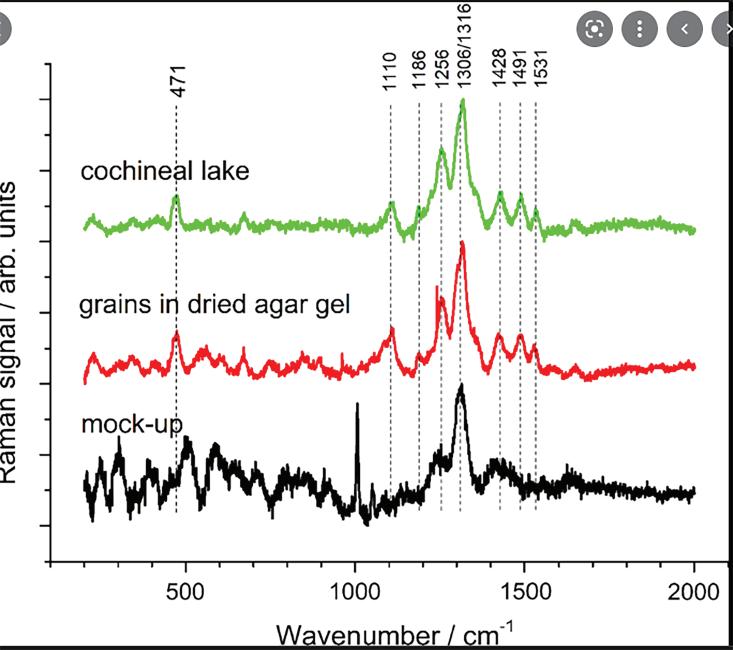
Figure 7. Silvia Innocenti, Marilena Ricci, Giancarlo Lanterna, Raff aella Fontana, Jana Striova, Maurizio Becucci, “Direct microextraction for red lakes detection in painting layers by Raman spectroscopy,” The European Physical Journal Plus, October 2021.
Conclusion and Comments
The ink used at the San Francisco post offi ce in August 1888 to mark incoming transit mail from Asia – in this case China – was determined to be Cochineal Lake Dye, not an ink at all. Made from the Cochineal beetle (Dactylopius coccus), this dye was used by the Aztecs 1,500 years ago. Spanish explorers imported it into Europe to be used as a clothing dye. Renaissance artists used it, as well. It so far appears unique to the post offi ce at San Francisco as an incoming marking ink. On outgoing mail, the CDS mark was hand stamped in a black ink. Testing of a similar “red” ink on an 1870 cover from New Haven, Conn., to Paris, one with a similar red color shade origin cancel, yielded Cinnabar (HgS). To date only two arrival lett ers in the United States from China dated 1886 and this cover 1888 have been tested, with both yielding the same result.
Keep up to date with what’s happening in our club: www.collectorsclub.org
286 September-October 2022 www.collectorsclub.org
Addendum: Color determination can be easily fooled by the naked eye
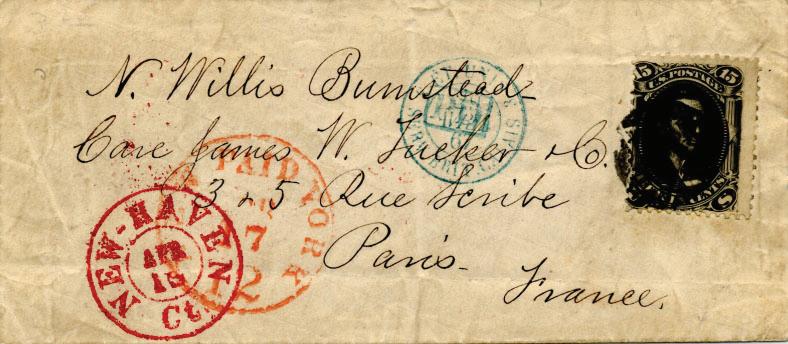
Figure 8. Lett er to Paris.
Figure 9. The Raman spectrum of the New Haven Red ink is the spectrum of cinnabar. The shades of red vary under the x50 microscope with identical bright red areas, but totally diff erent compounds.
The New Haven ink and the San Francisco ink color on the cover shown in Figure 8 are very similar and chemically diff erent, a bright red, redder than the New York “PAID” ink (Orange red). However, both red inks on this 1870 cover yield Cinnabar (HgS), a totally diff erent compound than the Cochineal Lake dye.
Cochineal Lake dye has an organic chemical formula of C22H20O13, while Cinnabar is an Inorganic compound, Mercury Sulfi de, HgS.
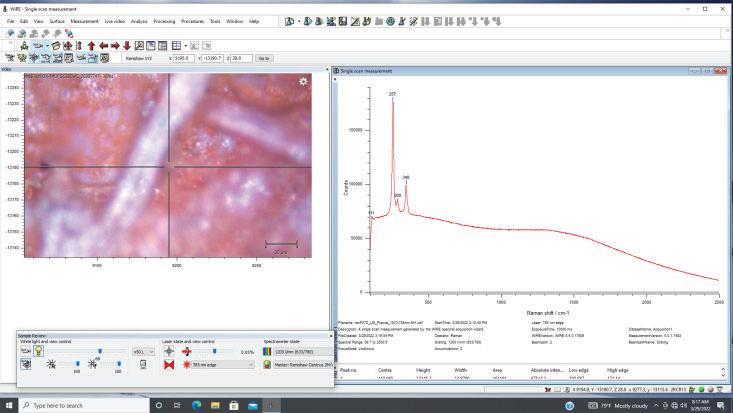
Collectors Club Philatelist Volume 101, Number 5 287
Guidelines for Articles
TEXT. All text for articles should be sent as a simple Word document using the “Normal” style – please don’t attempt to format for the magazine! Bold text, italics and tabs are ok. Text files may be sent as an email attachment or submitted via CD. Please, do not embed illustrations in your text document! Show the preferred location if you wish (or send a separate PDF showing your preference), but leave actual illustrations out. Send them separately. Simple, plain text always works best.
ILLUSTRATIONS. Illustrations are always preferred electronically as scans. Scans must be sized at a minimum of 100% and scanned at 300 dpi as TIF or JPG files for optimal quality. Internet transmittals, such as WeTransfer (preferred) may be used. A typical cover should be at least 1,500 pixels wide. If you do not have access to a scanner, originals may be sent. We will make scans and return originals immediately by the same method as they are sent to us. As a last resort, images may be sent to us as high-quality photocopies (hard copies made using a color laser copier and mailed to us). Again, please do not embed images in the text.
DEADLINES. The deadline for the receipt of articles, letters, advertising and news is the first of the month preceding the month of publication. For example, we need everything for a March-April issue by Feb. 1, September-October materials would need to arrive by Aug. 1, and so on. Your attention to – and compliance with – these standards will assure the highest-quality journal we can produce. Thank you for your contribution!
For Best Results Please Scan Illustrations at 300 dpi
288 September-October 2022 www.collectorsclub.org
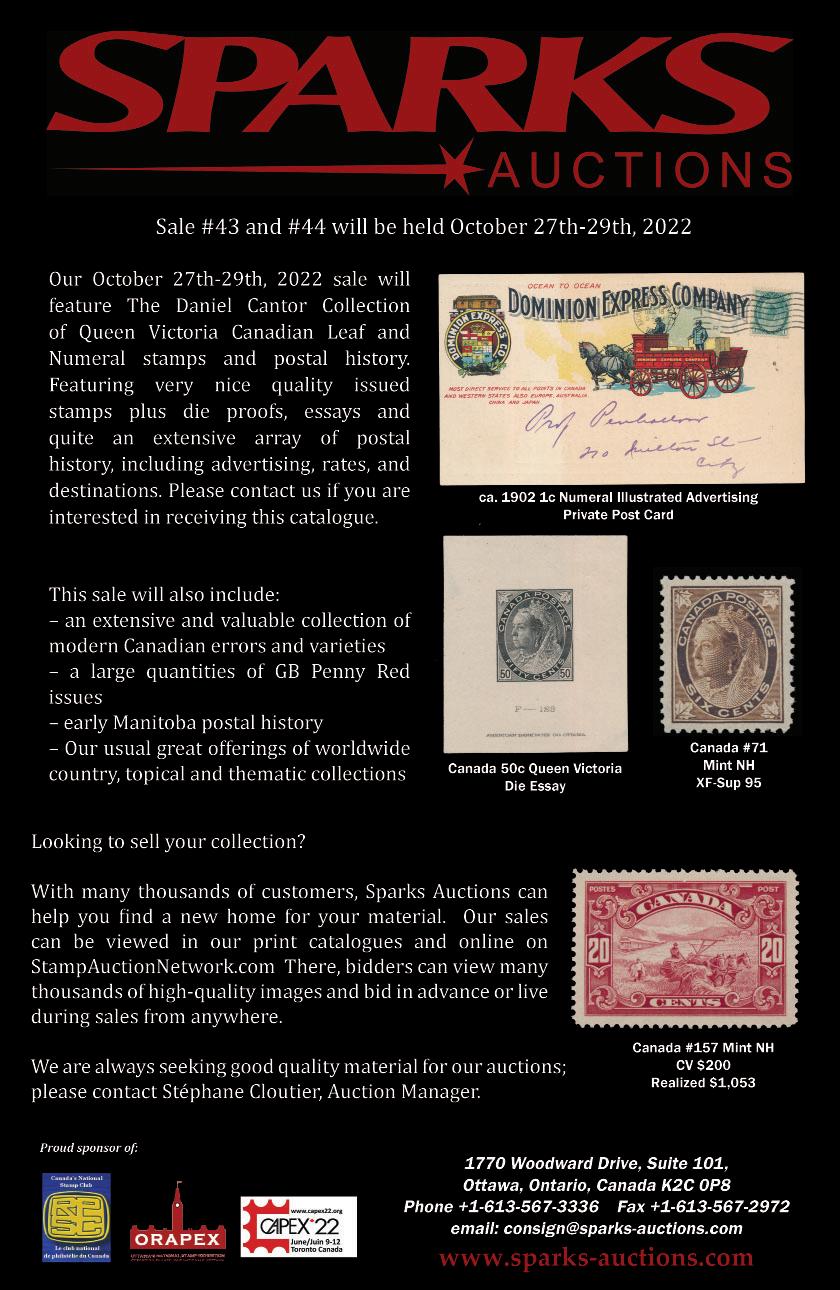
Collectors Club Philatelist Volume 101, Number 5 289










